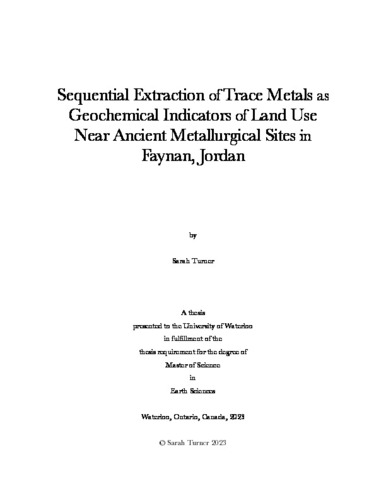| dc.description.abstract | Civilizations are tied to soils through a reliance on agriculture. In the Faynan Valley, southern Jordan, both the individuals who tend to the soils and the soils themselves have evolved through a series of environmental changes and adaptations in land use over the course of millennia. The desert sediments in the Faynan Valley hold a rich archaeological history that detail the millennia of metallurgy for which the region is known. The accumulation of metals through mining wastes in the sediments in Faynan pose a known danger that has afflicted the residents of Faynan since the Early Bronze Age when the production of copper moved out of the mines and into the wadis and agricultural fields. Metal residua from the processing and smelting of Cu and Mn ores remains in the sediment until physically broken down or removed. This research presents a new perspective on the extent and nature of the pollution in the hyper-arid sediments of Faynan, going beyond the known zones of high contamination in the immediate vicinity of archaeometallurgical sites and provding the missing link between metal concentrations in the sediments and the local flora and fauna.
Sediment samples were collected from two contemporaneous archaeological sites in the desert environment of Faynan; the alluvial Wadi 100 site with evidence of historical and modern agriculture and the aeolian Barqa el-Hetiye site near the base of a smelting ridge. Metals associated with mining (Cu, Mn, Pb) and elements associated with known archaeological features (Mg, P, Sr, Cd, Ni, Cr, Zn) were extracted in four operationally defined sediment fractions, including exchangeable, reducible, oxidizable, and residual fractions. The fractional distributions of these elements were measured and used to assess both the potential anthropogenic and natural sources of these elements in the Faynan Valley, and the potential risk to the biogeochemical environment associated with labile elements.
More than 50% of the total concentration of Mg, Mn, Sr, and Cd were recovered from the exchangeable fraction at both sites indicating that these elements are the most labile in the sediments analyzed. The largest proportion (> 40%) of Cr, Ni, Zn, Cu, and Pb were extracted from the residual fraction at both sites suggesting that these metals are the least mobile and not easily accessible to local biota. The sediments sampled from the Wadi 100 site have been altered by modern agriculture and irrigation, as evidenced by Cd, P, Mg, and Zn concentrations. The samples from the Barqa el-Hetiye site likely reflect element concentrations from a minimum of two stratigraphic layers, with at least one layer reflecting the local background concentrations and the redistribution of metals from more highly contaminated areas through aeolian and fluvial processes, and another layer indicative of archaeometallurgical contamination. These results show how the mobility of heavy metals associated with archaeometallurgical activity in Faynan is dependent on soil properties and how variations in land-use, both historic and modern, can alter soil properties and thus the mobility and bioavailability of these metals. | en |

